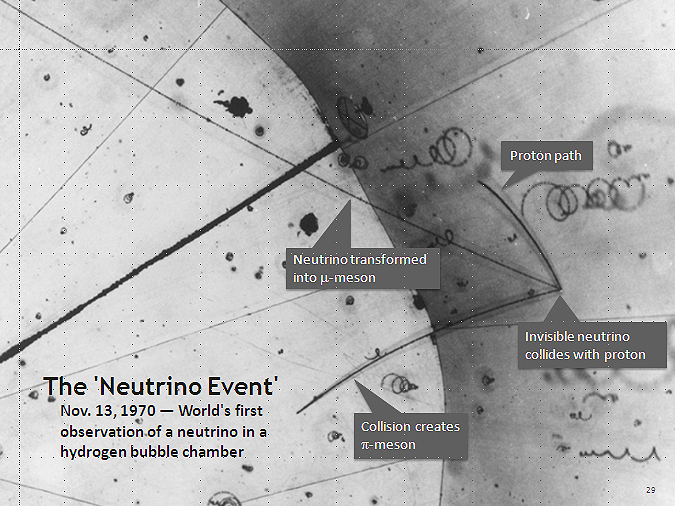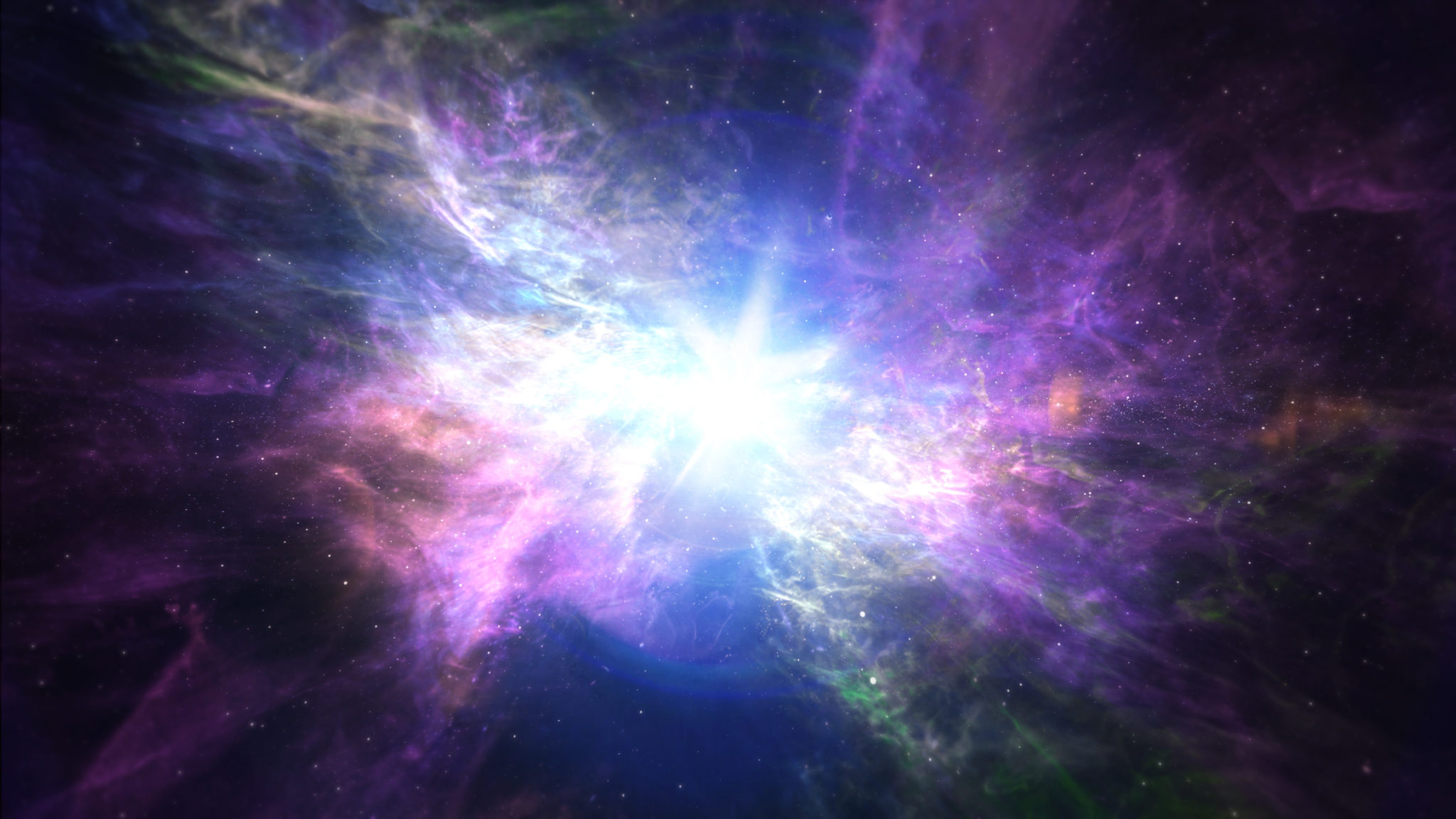Neutrino Breakthroughs: More Evidence for Cosmic Creation and Design
Sometimes the tiniest components of the universe reveal the greatest secrets. For nearly a century, scientists have predicted the existence and explanatory power of the neutrino—a particle that weighs so little no one has been able to measure its mass. Knowledge of its mass and behavior could help explain certain aspects of big bang cosmology. Scientists may be on the verge of just such a discovery with a successful measurement of a tighter range of the particle’s mass.
Famed physicist Enrico Fermi coined the term neutrino, which in Italian means “little neutral one,” to distinguish it from the more massive particle, the neutron. Neutrinos are elementary particles that interact only with gravity and the weak nuclear force. They are electrically neutral and possess a rest mass that is so tiny that—until a few decades ago—it was thought to be zero. Because the weak nuclear force has a very short range and the gravitational interaction is extremely weak, neutrinos typically pass through normal matter unimpeded and undetected.
Neutrinos are the most abundant known massive particles in the universe. On Earth’s surface, the majority of incoming neutrinos come from the Sun. They arrive on Earth’s surface at a rate of 65 billion neutrinos per second per square centimeter. Weak nuclear force interactions create neutrinos in three different leptonic “flavors” (types): electron neutrinos, muon neutrinos, and tau neutrinos.

Neutrino Masses
Since more than one flavor or type of neutrino exists and neutrinos can oscillate from one type to another, neutrinos cannot possibly be massless particles. This recognition has profound implications for both cosmic creation and particle creation models. Consequently, both astronomers and particle physicists have launched a quest to measure the masses of the three different types of neutrinos and to determine if there is the possibility that a fourth type of neutrino exists.
Measuring the individual masses of the different neutrino types is technologically extremely challenging. However, the measurement of the total mass of all the individual neutrino types (electron + muon + tau + mass of a possible fourth type of neutrino) is coming within researchers’ reach. To test cosmic and particle creation models, astronomers and particle physicists only need to know the total mass of all individual neutrino types. Though an accurate measurement of this total mass has eluded researchers, they have been able to determine a lower and upper limit to this mass. This exciting quest has occurred over the past few years, and especially the past few weeks. Scientific progress has brought the upper limit close enough to the lower limit to establish which of the many cosmic and particle creation models are correct.
I’ll explain the technical details so you can see how these remarkable measurements came about. If it’s too technical, feel free to skim the next few sections and glean what you can. Then, pick it up again at “Implications for the Standard Particle and Cosmic Creation Models.”
Minimum Neutrino Particle Masses
The neutrino oscillations that have been observed in numerous experiments1 establish two possible minima for the total mass of all the individual neutrino types. In the case where one of the three neutrino types possesses mass and the other two do not (known as the normal hierarchy), then the total minimum mass of the three neutrinos = 0.05885 ± 0.00044 electron volts (eV).2 Where two of the neutrino types possess mass and the third is massless (known as the inverted hierarchy), then the total minimum mass of the three neutrinos = 0.10000 ± 0.00068 eV.3 For comparison the rest mass of an electron = 511,000 eV.
Particle Physics Measurements of Maximum Neutrino Particle Masses
The mass measurement that best constrains cosmic and particle creation models is the maximum possible total mass of the three neutrino types. Hence, both particle physicists and astronomers have worked diligently to establish as low an upper limit to this total mass as their instruments will allow.
Using a tritium beta decay experiment, a team of particle physicists known as the Troitsk Collaboration determined that the total mass of the three neutrino types could not be any greater than 2.5 eV.4 A similar experiment by the Mainz Collaboration established an upper mass limit of 2.2 eV.5
In 2019, the KArlsruhe TRItium Neutrino Experiment (KATRIN) analyzed the spectrum of beta-decay electrons from a high-purity gaseous molecular tritium source. This analysis yielded an upper mass limit for the three neutrino types of 1.1 eV.6 In future experimental runs the KATRIN team will achieve a measuring sensitivity down to 0.2 eV.7
Astronomical Measurements of Maximum Neutrino Particle Masses
Cosmological data sets provide an independent measure of the upper mass limit of the three neutrino types, measurements that prove to be much more constraining. The properties of dark energy affect the total mass of the three neutrino types. This mass also determines the free-streaming nature of neutrinos, which impacts the large-scale structure of galaxies and galaxy clusters in different ways at different times in the history of the universe.
Based on the 2018 Planck map of the cosmic microwave background radiation (the radiation remaining from the cosmic creation event), a team of three theoretical physicists established an upper bound on the total mass of the three neutrino types for the normal hierarchy = 0.156 eV and for the inverted hierarchy = 0.185 eV.8 The Planck Collaboration of 181 astronomers and physicists established an upper limit = 0.12 eV for both the normal and inverted hierarchies.9 Adding an analysis of transversal baryon acoustic oscillation data, a team of four astronomers placed an upper bound limit of 0.11 eV.10 Based on the Sloan Digital Sky Survey—IV extended Baryon Oscillation Spectroscopic Survey (eBOSS), a team of 98 astronomers determined an upper bound limit of 0.099eV, which degraded to 0.114 eV with the addition of gravitational lensing data on distant galaxies.11
A few weeks ago, three physicists published the most constrained upper limit to date on the mass sum of the three neutrino types.12 Their improved limit was achieved thanks to their addition of analyses of the latest surveys of redshift space distortions and luminous red galaxies. Their upper mass limit = 0.087 eV at a 95% confidence level, which means that with a 95% probability we can be certain that the mass sum of the three neutrino types must be less than 0.087 eV.
Implications for the Standard Cosmic and Particle Creation Models
Astronomers now have a measured mass limit—at a 95% confidence level—for the sum of the three neutrino types that is 0.013 eV below what is required for an inverted hierarchy. This measurement does not eliminate the inverted hierarchy model, but it does make it highly unlikely.
The new constraints on the mass limit for the sum of the three neutrino types imply a slightly smaller value for the amount of dark matter in the universe. They also imply a slightly larger value for the average cosmic expansion rate, aka the Hubble constant.
That the sum of the three neutrino types’ mass lies between 0.05841 and 0.087 eV implies a growth rate for the spatial structure of the universe’s mass that is consistent with the temperature and polarization maps of the cosmic microwave background radiation. It is also consistent with general relativity explaining the dynamics of galaxies and galaxy clusters throughout the universe. This consistency provides even more evidence for the ΛCDM (Lambda cold dark matter) cosmic creation model; that is, for a big bang creation model where the most dominant component of the universe is dark energy and the second-largest component of the universe is cold dark matter. As I explained in two previous articles,13 more than 2,500 years before astronomers even had a hint that the universe arose from a big bang creation event, the Bible described the cosmos in terms that align with the four most fundamental features of big bang cosmology.
The cosmological observations that produced the best constraints on the sum of the three neutrino types’ mass also produced yet more evidence for the fine-tuning of the constant or constants governing dark energy. As one team of astronomers wrote in their paper published just a few months ago, “This fine-tuning represents a theoretical difficulty without any agreed-upon resolution and one that may not be resolvable through fundamental physics considerations alone. This difficulty has been substantially sharpened by the observations presented here.”14 The difficulty of accounting for such fine-tuning of the constant(s) governing dark energy that they write about is an intractable problem only for nontheistic models of the universe. For the God of the Bible it is no problem to fine-tune a cosmic parameter to better than 1 part in 10122 to make advanced life in the universe possible.
*In next week’s Today’s New Reason to Believe article I will describe the latest measurements constraining the possible existence of a fourth neutrino type and the philosophical implications of these measurements.
Endnotes
- K. Abe et al. (T2K Collaboration), “Observation of Electron Neutrino Appearance in a Muon Neutrino Beam,” Physical Review Letters 112, no. 6 (February 14, 2014): id. 061802, doi:10.1103/PhysRevLett.112.061802; J. K. Ahn et al. (RENO Collaboration), “Observation of Reactor Electron Antineutrinos Disappearance in the RENO Experiment,” Physical Review Letters 108, no. 19 (May 11, 2012): id. 191802, doi:10.1103/PhysRevLett.108.191802.
- Shouvik Roy Choudhury and Steen Hannestad, “Updated Results on Neutrino Mass and Mass Hierarchy from Cosmology with Planck 2018 Likelihoods,” Journal of Cosmology and Astroparticle Physics 2020, no. 7 (July 2020): id. 037, doi:10.1088/1475-7516/2020/07/037I; Ivan Esteban et al., “Global Analysis of Three-Flavour Neutrino Oscillations: Synergies and Tensions in the Determination of θ23, δCP, and the Mass Ordering,” Journal of High Energy Physics 2019 (January 2019): id. 106, doi:10.1007/JHEP01(2019)106.
- Choudhury and Hannestad, “Updated Results on Neutrino Mass”; Esteban et al., “Global Analysis.”
- V. N. Aseev et al. (Troitsk Collaboration), “Upper Limit on Electron Antineutrino Mass from Troitsk Experiment,” Physical Review D 84 (December 11, 2011): id. 112003, doi:10.1103/PhysRevD.84.112003.
- Christine Kraus et al., “Final Results from Phase II of the Mainz Neutrino Mass Search in Tritium β Decay,” European Physical Journal C—Particles and Fields 40 (April 2005): 447–468, doi:10.1140/epjc/s2205-02139-7.
- M. Aker et al., “Improved Upper Limit on the Neutrino Mass from a Direct Kinematic Method by KATRIN,” Physical Review Letters 123, no. 22 (November 25, 2019): id. 221802, doi:10.1103/PhysRevLett.123.22180.
- Karlsruhe Institute of Technology, KATRIN: Karlsruhe Tritium Neutrino Experiment, accessed November 1, 2021, https://www.katrin.kit.edu.
- Ming Zhang, Jing-Fei Zhang, and Xin Zhang, “Impacts of Dark Energy on Constraining Neutrino Mass after Planck 2018,” Communications in Theoretical Physics 72, no. 12 (December 1, 2020): id. 125402, doi:10.1088/1572-9494/abbb84.
- N. Aghanim et al. (Planck Collaboration), “Planck 2018 Results. VI. Cosmological Parameters,” Astronomy & Astrophysics 641 (September 2020): id. A6, doi:10.1051/0004-6361/201833910.
- Rafael C. Nunes et al., “Cosmological Parameter Analyses Using Transversal BAO Data,” Monthly Notices of the Royal Astronomical Society 497, no. 2 (September 2020): 2133–2141, doi:10.1093/mnras/staa2036.
- Alam Shadab et al., “Completed SDSS-IV Extended Baryon Oscillation Spectroscopic Survey: Cosmological Implications from Two Decades of Spectroscopic Surveys at the Apache Point Observatory,” Physical Review D 103, no. 8 (April 28, 2021): id. 083533, doi:10.1103/PhysRevD.103.083533.
- Eleonora Di Valentino, Stefano Gariazzo, and Olga Mena, “Most Constraining Cosmological Neutrino Mass Bounds,” Physical Review D 104, no. 8 (October 2021): id. 083504, doi:10.1103/PhysRevD.104.083504.
- Hugh Ross and John Rea, “Big Bang—The Bible Taught It First!,” Facts For Faith (Quarter 3, 2000), 26–32; Hugh Ross, “Does the Bible Teach Big Bang Cosmology,” Today’s New Reason to Believe (blog) Reasons to Believe, August 26, 2019.
- Shadab et al., “Completed SDSS-IV Extended Baryon Oscillation Spectroscopic Survey,” 28.






